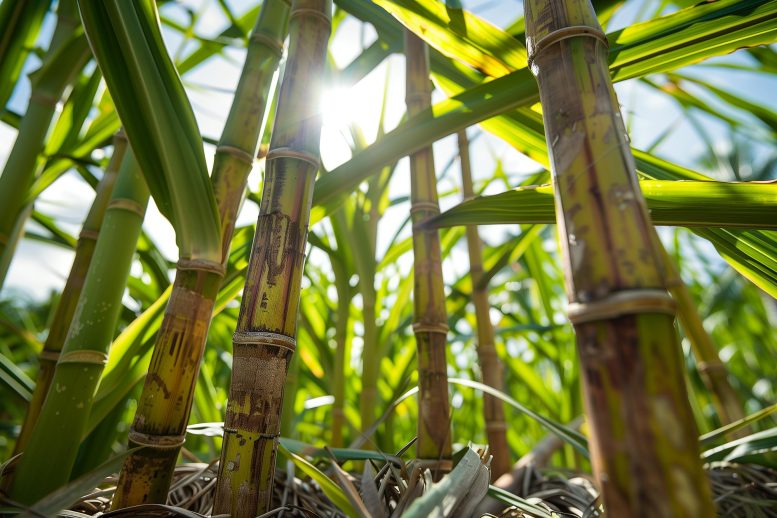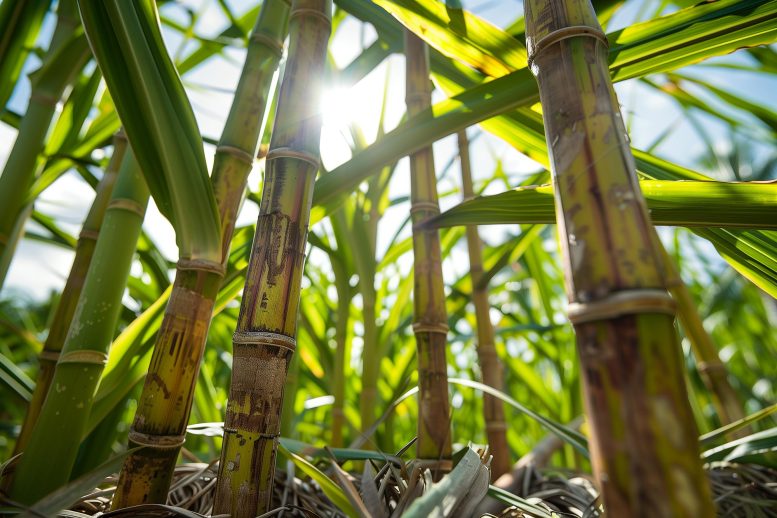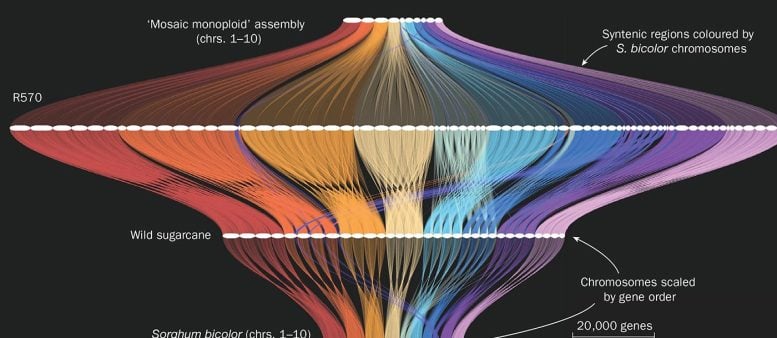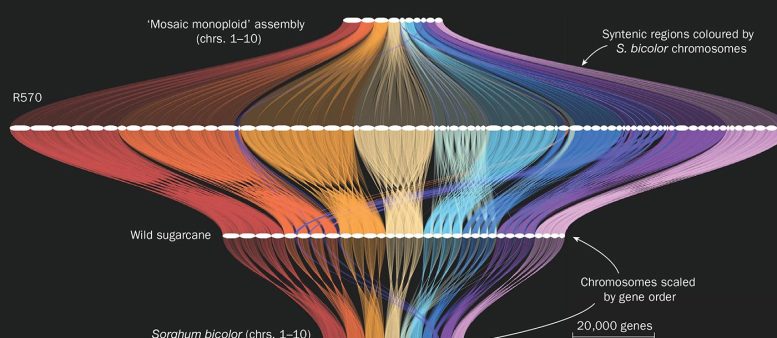

Researchers have decoded the complex genome of sugarcane, revealing its immense size and potential for improving crop resilience and developing renewable resources. This scientific breakthrough, a result of a decade-long international collaborative effort, paves the way for advanced breeding techniques and new applications in bioenergy and beyond. Credit: SciTechDaily.com
Unveiling sugarcane’s genome, scientists set the stage for innovative breeding and renewable carbon sourcing, heralding a new era in agricultural research and sustainability.
Researchers have unraveled the mystery of sugarcane genetics, finding the crop’s genome is three times the size of the human genome and more complex.
After a decade of research, scientists from The University of Queensland, Australia’s national science agency CSIRO, and Sugar Research Australia (SRA) have been able to fully map the sugarcane genome for the first time.
Breakthrough in Sugarcane Genome Mapping
Co-author Professor Robert Henry from the Queensland Alliance for Agriculture and Food Innovation said sugarcane was the last of the world’s 20 major crops to have its genome mapped.
“This marks the start of the genomic revolution for sugarcane, and now we have the knowledge to level the playing field with other crops,” Professor Henry said.
“While this genome mapping will be a tool to help create more resistant sugarcane crops, it is also a major step forward for our other research to turn sugarcane and other plant biomass into aviation fuel.”


This image shows a gene order map (created using GENESPACE) that compares genome assemblies among related plant species. The horizontal white lines represent chromosomes, and the colored braids that link them show conserved blocks of genes. This enables researchers to track conserved genes of interest from well-researched crops (such as Sorghum bicolor; a specific type of sorghum) into more complex genomes, such as wild sugarcane and cultivar R570, to better understand their function. For contrast, the previous monoploid assembly of R570 is provided on the top row, where multiple chromosome copies in the genome were represented as a single, mosaic assembly. Credit: Adam Healey and John Lovell/HudsonAlpha
Renewable Carbon and Sugarcane’s Potential
Professor Henry is developing renewable carbon products from plant biomass for use as cost-effective and sustainable aviation fuel as part of the ARC Research Hub for Engineering Plants to Replace Fossil Carbon.
“Traditionally sugarcane has been bred just for sugar but now with the move to net zero, there is great interest in one of the most productive crops in the world becoming a source of renewable carbon,” he said.
“This genome mapping will help us produce sugarcane that’s a better raw material to replace fossil carbon.”
Impact on Sugarcane Research and Industry
Principal Investigator and CSIRO Research Scientist Dr. Karen Aitken said the breakthrough in genome mapping addressed the critical challenge of stagnating sugar yields by tapping into the previously inaccessible genetic diversity of sugarcane.
“This is a major step forward for sugarcane research and will improve our understanding of complex traits like yield and adaption to diverse environmental conditions as well as disease resistance,” Dr. Aitken said.
“This is the first high-quality sugarcane variety genome to be completed.
“It represents a significant scientific achievement from 10 years of collaborative effort from scientists across the world.
“This knowledge opens opportunities for new tools to enhance breeding programs around the world for this valuable bioenergy and food crop.”
Sugar Research Australia cytogeneticist Dr. Nathalie Piperidis said the unveiling of the sequence would create a plethora of opportunities.
“Sugar Research Australia takes immense pride in its involvement in this remarkable accomplishment,” Dr. Piperidis said.
“Not only does the work hold the promise of enhancing our understanding of this amazing crop but it will also offer unprecedented ways to advance breeding techniques within the industry to produce a range of renewable and commercially viable products that include but go way beyond sugar.”
The research paper was published in Nature.
For more on this study, see Unlocking the Sweet Mysteries of Sugarcane DNA.
Reference: “The complex polyploid genome architecture of sugarcane” by A. L. Healey, O. Garsmeur, J. T. Lovell, S. Shengquiang, A. Sreedasyam, J. Jenkins, C. B. Plott, N. Piperidis, N. Pompidor, V. Llaca, C. J. Metcalfe, J. Doležel, P. Cápal, J. W. Carlson, J. Y. Hoarau, C. Hervouet, C. Zini, A. Dievart, A. Lipzen, M. Williams, L. B. Boston, J. Webber, K. Keymanesh, S. Tejomurthula, S. Rajasekar, R. Suchecki, A. Furtado, G. May, P. Parakkal, B. A. Simmons, K. Barry, R. J. Henry, J. Grimwood, K. S. Aitken, J. Schmutz and A. D’Hont, 27 March 2024, Nature.
DOI: 10.1038/s41586-024-07231-4
The research was funded by the Joint Genome Institute (USA) through the US Department of Energy community sequencing program.
The Queensland Alliance for Agriculture and Food Innovation is a research institute at The University of Queensland supported by the Queensland Government via the Department of Agriculture and Fisheries.
